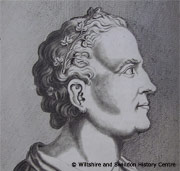Antiquarian Activity
 In England in the 15th and 16th century there was an increasing interest in the curiosities of the past and a rising awareness that the past had been materially different from the present.
In England in the 15th and 16th century there was an increasing interest in the curiosities of the past and a rising awareness that the past had been materially different from the present.
This rising awareness is represented by William Camden's Britannia (1586) the first comprehensive topographic survey of England. Camden was also a founding member of the societies of antiquaries, and his descriptions of the topography of Dorset and Wiltshire include descriptions of the prehistoric archaeology of the AONB.
"Willy [Wylye], a Village some miles distant: over against it a very large warlike fence or hold, and the same fortified with a deepe and duple Ditch. The neighbour-dwellers call it Yanesburie [Yarnsbury] Castle, And by the forme and maner of making, a man may easily know it was a Romane Campe" William Camden 1586
The most famous of the 17th century antiquarians was John Aubrey (1626-1697). He worked primarily in Wiltshire and produced a 'Natural History of Witshire' which as well as describing such miscellany as 'Springs Medicinal', and 'Reptiles and Insects' also includes a section on 'Architecture' which includes prehistoric sites, and ruins alongside stately homes.
"Wardour Castle, the seate of the Lord Arundell, was kept by Col Ludlow: a part of it was blown up by Sir F. Dodington in 1644 or 1645.Here was a red-deer parke and a fallow-deer parke." John Aubrey (first published 1847)
It was during the eighteenth century that antiquarians such as William Stukeley (1687-1765) began to recognise that there hads been a lengthy pre roman occupation of the British Isles and began to try to ascertain relative dates for archaeological sites which had no historical record. It was Stukeley who first noted that the Roman Road called the Ackling Dyke in the AONB cut through one of the disc barrows of the Bronze Age cemetery on Oakley Down.
 Antiquarianism continued to develop in the late 18th century with a growing emphasis on excavation and some of the best work was undertaken by Wiliiam Cunnington (1754-1810) and his patron Richard Colt Hoare who lived at Stourhead in Wiltshire. They excavated many sites in Southern Wiltshire and some in Dorset including 379 barrows systematically recording their findings and using stratigraphy to distinguish between primary and secondary burials.
Antiquarianism continued to develop in the late 18th century with a growing emphasis on excavation and some of the best work was undertaken by Wiliiam Cunnington (1754-1810) and his patron Richard Colt Hoare who lived at Stourhead in Wiltshire. They excavated many sites in Southern Wiltshire and some in Dorset including 379 barrows systematically recording their findings and using stratigraphy to distinguish between primary and secondary burials.
Download a short introduction to the history of archaeological discovery in the AONB (PDF 851 KB).
This document forms part of the wider AONB Historic Environment Action Plans.
